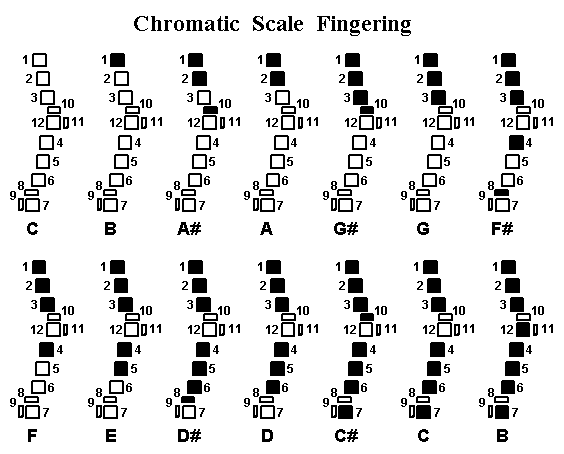The Stealth Fingering Charts
The keyworks system comprises 17 keys -- three octave keys and 14 finger keys. Every combination of finger keys is legitimate and produces a valid note, so there are over 16,000 fingerings per (extended) octave. I'll only show some of them.
The first diagram shows the fingerings I use for chromatic scales. It's the most comfortable set I've found that doesn't use cross fingerings. Viable alternatives in this scale are to use key 2 (alone) for A# and keys 1+ 2+ 3+ 5 for F#.
 The second diagram illustrates fingerings that extend each register beyond the octave breaks. My previous controller had just two pinky keys on each hand and worked quite well, so having three on each side is a bit of a luxury. It's more clarinet-like than the previous model, so I can use more of my old training.
The second diagram illustrates fingerings that extend each register beyond the octave breaks. My previous controller had just two pinky keys on each hand and worked quite well, so having three on each side is a bit of a luxury. It's more clarinet-like than the previous model, so I can use more of my old training.
 The second diagram also illustrates some of the kinds of alternate fingerings that are possible with this highly flexible system. The example given shows four ways to finger D#. The upper two are the ones used the most. The one on the lower left can be used for fingering a c-minor chord without cross fingering. The one on the lower right is not useful and is never used. A fingering not shown that is sometimes useful is 1+2+3+4+7. In general, fingerings that are similar to standard woodwind fingerings can be found for most passages. Simpler fingerings than would normally be possible can also often be found. For example, a C# scale can be fingered like a simple C scale, except with the addition of key 10 being held down.
The second diagram also illustrates some of the kinds of alternate fingerings that are possible with this highly flexible system. The example given shows four ways to finger D#. The upper two are the ones used the most. The one on the lower left can be used for fingering a c-minor chord without cross fingering. The one on the lower right is not useful and is never used. A fingering not shown that is sometimes useful is 1+2+3+4+7. In general, fingerings that are similar to standard woodwind fingerings can be found for most passages. Simpler fingerings than would normally be possible can also often be found. For example, a C# scale can be fingered like a simple C scale, except with the addition of key 10 being held down.
Back Home
 The second diagram illustrates fingerings that extend each register beyond the octave breaks. My previous controller had just two pinky keys on each hand and worked quite well, so having three on each side is a bit of a luxury. It's more clarinet-like than the previous model, so I can use more of my old training.
The second diagram illustrates fingerings that extend each register beyond the octave breaks. My previous controller had just two pinky keys on each hand and worked quite well, so having three on each side is a bit of a luxury. It's more clarinet-like than the previous model, so I can use more of my old training. The second diagram also illustrates some of the kinds of alternate fingerings that are possible with this highly flexible system. The example given shows four ways to finger D#. The upper two are the ones used the most. The one on the lower left can be used for fingering a c-minor chord without cross fingering. The one on the lower right is not useful and is never used. A fingering not shown that is sometimes useful is 1+2+3+4+7. In general, fingerings that are similar to standard woodwind fingerings can be found for most passages. Simpler fingerings than would normally be possible can also often be found. For example, a C# scale can be fingered like a simple C scale, except with the addition of key 10 being held down.
The second diagram also illustrates some of the kinds of alternate fingerings that are possible with this highly flexible system. The example given shows four ways to finger D#. The upper two are the ones used the most. The one on the lower left can be used for fingering a c-minor chord without cross fingering. The one on the lower right is not useful and is never used. A fingering not shown that is sometimes useful is 1+2+3+4+7. In general, fingerings that are similar to standard woodwind fingerings can be found for most passages. Simpler fingerings than would normally be possible can also often be found. For example, a C# scale can be fingered like a simple C scale, except with the addition of key 10 being held down.